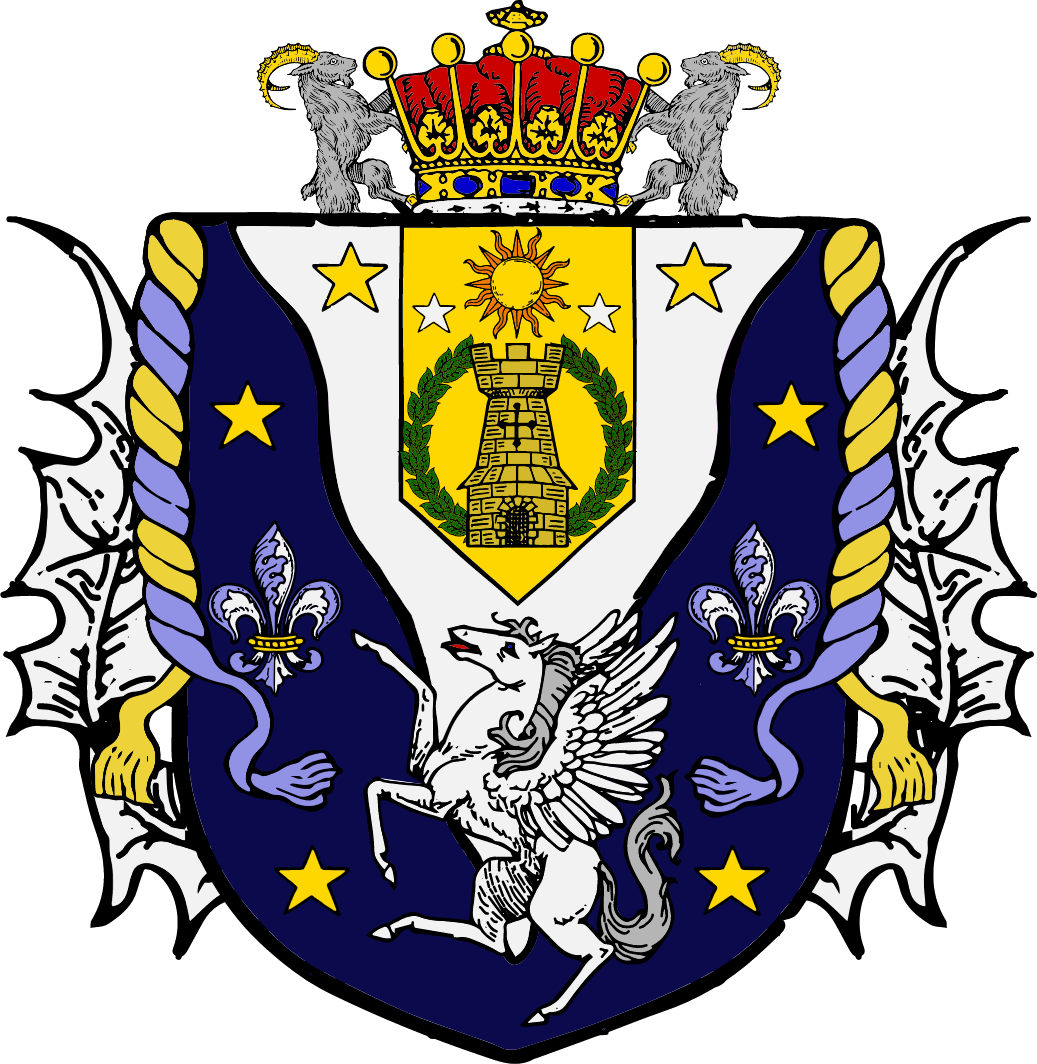Oremis

The Blessed City of Oremis (Or., Sodsagrád de Auremys) is also known as the Crown of the Crossroads due to its advantageous position at the heart of the Kingdom of Basca. Its name is Old Bascan for prosperous hill, translated literally as “mound of gold overlooking (or watching over) the earth.”
(Above: The Oremisian coat of arms — Azure, chaussé ployé Azure and Argent, on a flag Or one tower Or, two stars Argent, one sun Or and Tenné, one laurel wreath Vert, a pegasus segreant Argent langued Gules, two fleurs-de-lis Azure Argent and Or, six stars Or)
The city’s name comes from that of Sancta Aurellya of the Valley, one of the city’s angel-saints who featured prominently in its foundation myths. Elsewhere to the west, ae was sometimes known as Orelliel. Oremis’s neighbouring territories are Calgaremi to the north; Magra to the east; Talvareyna to the south; and Lhión through the west, on the other side of the Forest of Rivers.
A large, cosmopolitan city benefitting from a robust trade network, it is also well-known for its sloping hills; its metalwork, particularly its swordsmiths; its limestone reserves; the grandeur of its architecture; and, of course, the free nature of the magic that lives within its wards. Under Reimundo di Volaans, Oremis grew into a worldly city that promoted literacy, the arts, and exhaustive trade.
The first inhabitants of the area that would later become known as Oremis proper were witches who were drawn to the magic emanating from the highly irregular amount of intersecting ley lines beneath its beautiful hills and valleys. As a result, a large number of covens from all over Basca proceeded to establish themselves there. In the city’s earliest days, Oremis’ natural magic continued to be attractive to casters even as other towns began popping up in its vicinity.
With Basca divided between itself, Northern Basca remains in a constant state of civil war with itself, too. Part of the continuous conflict in the North lies in magic: those who defend it, and those who abhor it.
Though Basca has a monarch, some cities operate largely independently, led by dukes, councils, or other rulers who nominally answer to the king, but mostly manage their territories on their own. Oremis is one such city, in particular because of the depth of its coffers. Unfortunately, rule is complicated by the omnipresent Church of Basca, which aspires to be the sole ruling power.
Oremis’ relationship with the Church of Basca is a long, storied one, and began when Ehagan de Aminsál, an elder of the Coven of Aminsál, agreed to deliver Oremis to the Church of Basca under the Osoçais Accord. For generations, with the new House Velo de Edén as their right hand, leadership fashioned Oremis as the mightiest arm of the Church militant.
During this time, Church patronage allowed the city to thrive, with officials funnelling gold into enormous building projects that spoke to the Church’s growing prestige. Thanks to this widespread artistic and arhcitectural programme, Oremis experienced an influx of artists and craftsmen from significant cultural centres like Gervasi, Cortesi, and Catalunya. Along with them came the merchants, other casters, and even younger-born nobles seeking to take advantage of a golden city ascendant. As much as Oremis is a city of weaponsmiths and warriors, it is also a city of creatives and appreciators.
Following the inception of the Inquisition, House Velo de Edén’s relationship with the Church deteriorated — and Oremis’ relationship with the Church followed. Velo de Edén denounced the Inquisition and Church both, and changed their Bascan name to Edenveil, in the Common Tongue. Turning on their former patron was seen as a betrayal by the Church, who excommunicated them, the Edenveils led the Oremeños through three subsequent uprisings against the Inquisition — and three subsequent victories, with the third being final and decisive.
Before the Church’s power grew, Oremisian casters and voidborn enjoyed a civil, symbiotic relationship, with both populations living amongst each other. Though rare for the time, intermarriage between casters and voidborn also began to appear during this time, even if both populations were wary, for varying reasons, about marrying one another. Despite the best efforts of the Church throughout its temporary omnipresence in Oremis, this relationship continued to develop mostly positively, and advocates for casters to remain amongst casters and voidborn amongst the voidborn were loud, but they were, significantly, a minority.
For the magical and the voidborn alike, Oremis is a sanctuary city — a safe haven — and it takes this position very seriously. Despite its earlier status as a stronghold of the Church and the mightiest arm of the Church militant in Basca, it has transformed into a beacon and safe haven for those wishing to escape persecution — magical or otherwise. Smaller cities like San Vinharre to the east look westward to Oremis as inspiration on the long, ongoing, gruelling fight against the Church and the Inquisition, who seek to eradicate magic in the name of consolidating power for the Church. Oremis is proud of the safety it provides for those who come seeking it. It is anathema to an Oremeño to turn away anyone seeking sanctuary.
✶ Burning with faith This city motto takes on many meanings in the face of worship of the First Mother and persecution by the Church of Basca, who co-opted magical fire firstly to mean holiness and purity before establishing the Inquisition and calling it the fire of the damned.